15 Types of BLACK And WHITE Woodpeckers (ID Guide w. Photos)
Did you recently come across a black and white woodpecker, and want to know what species it was?
Identifying woodpeckers that are black and white is not as easy as it might seem, since there are surprisingly many woodpeckers (plus closely related sapsuckers) in North America that fit this description.
To help you identify the bird you saw, we’ll cover all the black and white woodpeckers of North America.

What species of woodpeckers in North America are black and white?
There are 15 species of woodpeckers in North America that are black and white, which are described in full detail below.
We’ve included sapsuckers in this list as they are generally classified together with woodpeckers, and also look very similar.
White-headed Woodpecker
Scientific name: Dryobates albolarvatus
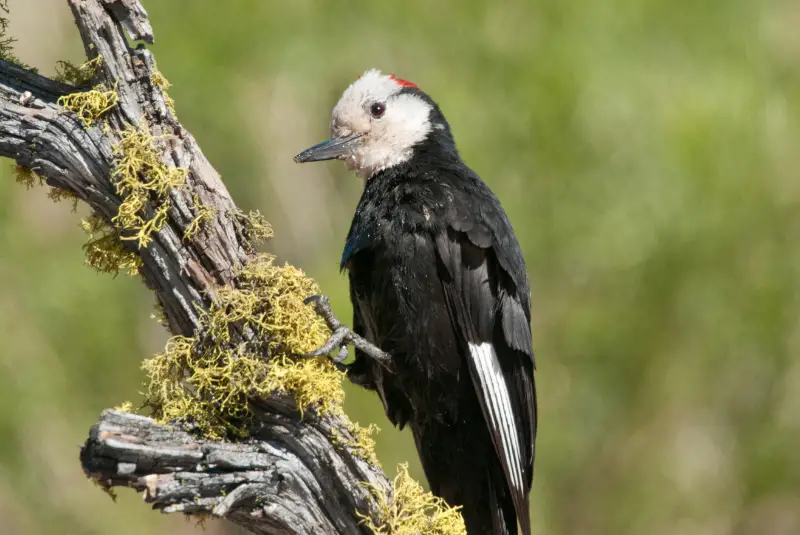
The White-headed Woodpecker is a bird of the western United States, where it is found in mountainous areas.
This large black-and-white bird has a black body with a white head and a white stripe on the wing. In addition to this, males also have a bright red patch on the rear part of their head.
These woodpeckers live in pine forests, where they forage for seeds by assiduously hammering them out of pine cones.
Black-backed Woodpecker
Scientific name: Picoides arcticus
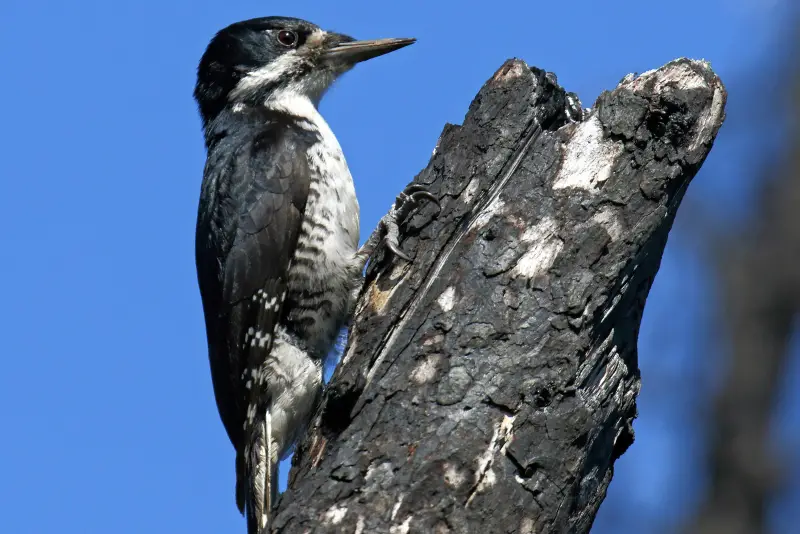
The Black-backed Woodpecker is a medium-sized bird with striking black and white coloration. Its jet coal back and wings contrast with its white underside and gray barring on the flanks.
This species inhabits Canada’s boreal forests, some parts of Alaska, as well as a few areas of the western United States.
Black-backed Woodpeckers thrive in coniferous forests that have recently burned, and their coal black plumage provides excellent camouflage in this environment.
These birds are adept at finding wood-boring insects like bark beetles that they extract from dead or dying trees with their sturdy bills.
American Three-toed Woodpecker
Scientific name: Picoides dorsalis
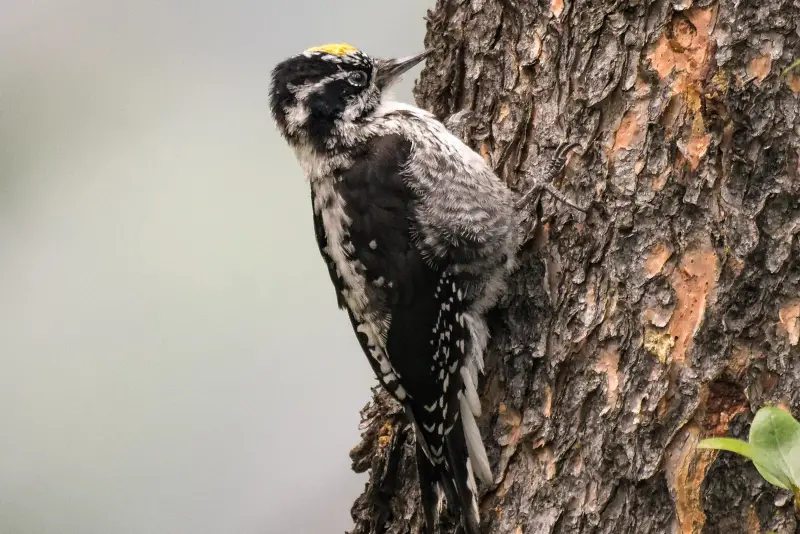
The American Three-toed Woodpecker’s resemblance to the Black-backed Woodpecker may cause confusion but its distinguishing features include a black-and-white striped face, black back with white barring and predominantly white underside.
Its name derives from the fact that this bird only possesses three toes on each foot compared to other woodpeckers which have four toes per foot.
These woodpeckers thrive in boreal forests throughout Canada and Western United States, and similar to their close relative, the Black-backed Woodpecker, they also benefit from coniferous forests that have been burned by forest fires.
Red-headed Woodpecker
Scientific name: Melanerpes erythrocephalus
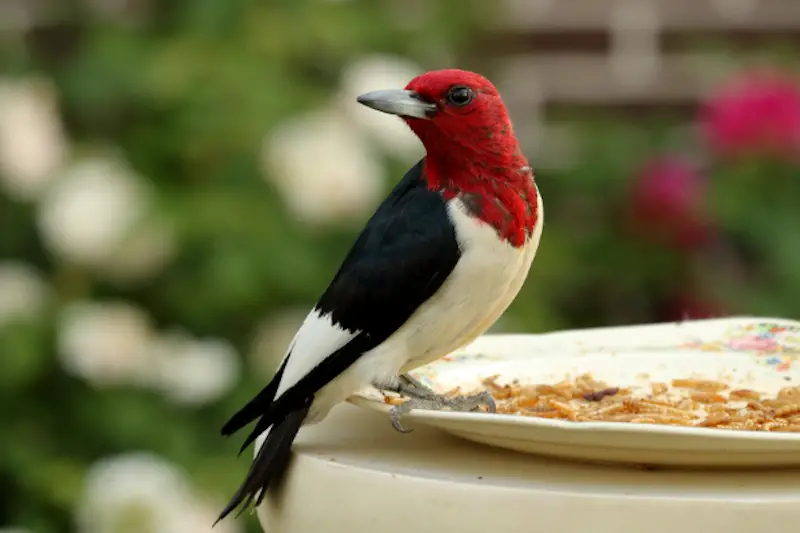
The Red-headed Woodpecker is one of the few non-dimorphic woodpeckers, which means that males and females look alike.
Red Headed Woodpeckers have an all-red head with a solid black back. They also have a white chest, rump and belly, as well as black wings and a black tail. The bill and legs are gray.
The Red-Headed Woodpecker favors wide-open deciduous or coniferous forest habitats, or forests with plenty of dead or rotten limbs.
It may use the same nest cavity for multiple years in a succession, in contrast to other woodpeckers that only use them once or for a small period of time.
This bird used to be common throughout North America, but the population has unfortunately declined by more than 90 percent, and it is now a rare sight in many parts of the US.
Red-bellied Woodpecker
Scientific name: Melanerpes carolinus
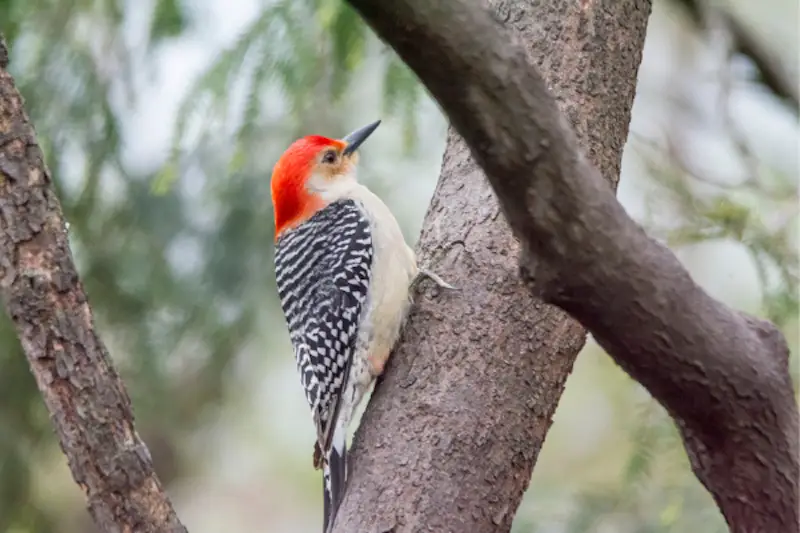
The Red-bellied Woodpecker has a black-and-white “Zebra” pattern on its back, as well as a white rump.
Males have a red crown that goes all the way down to the base of the neck. Both sexes look similar, but the female lacks the red cap on its head.
This bird favors shady woodlands, forest edges and backyards with old trees.
It excavates holes in rotting wood to locate beetles, centipedes, spiders, and other creatures.
During winter, this black and white colored bird with a red head stores berries and acorns in tree crevices and cracks. Every year, the Red-bellied Woodpecker excavates a new nest below the previous one in the same tree.
While this bird is named for the rufous tinge on its belly, this can be hard to see unless you get a close up view.
Fortunately, this beautiful bird is steadily expanding its range across the whole country.
Pileated Woodpecker
Scientific name: Dryocopus pileatus
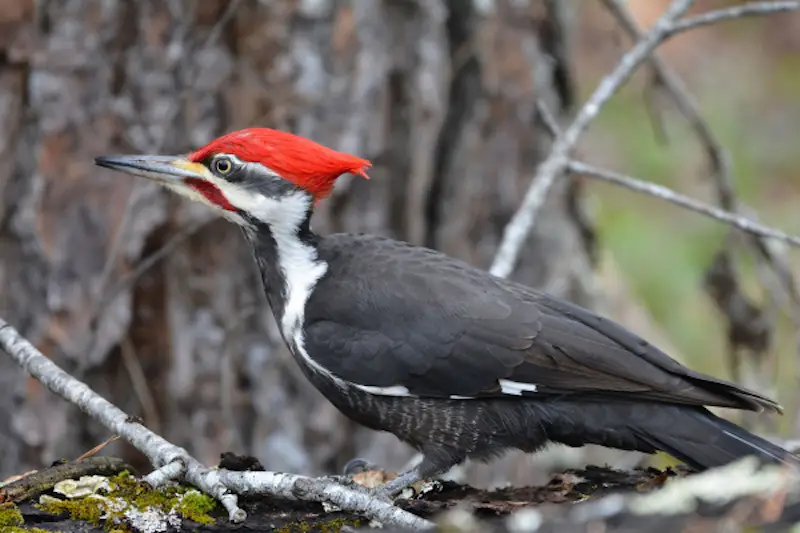
The Pileated Woodpecker is a large, crow sized woodpecker that has a bright red crest and forehead, as well as a black and white striped face and neck
The rest of this bird’s body is mostly black, although the white front edges of the wings flash brightly during flight.
The Pileated Woodpecker is the largest woodpecker in North America, and is a very shy bird that is mostly found in extensive tracts of woodland.
In order to find insects to eat, it drills oval holes in tree trunks that may be up to several feet long.
You can find large wood chips lying on the ground around its feeding trees, which is a tell-tale sign that Pileated Woodpeckers have been at work.
Carpenter ants are its favorite snack, and it feeds its nestlings regurgitated insects. The young birds leave the nest with pretty much the same appearance as adults.
Hairy Woodpecker
Scientific name: Picoides villosus
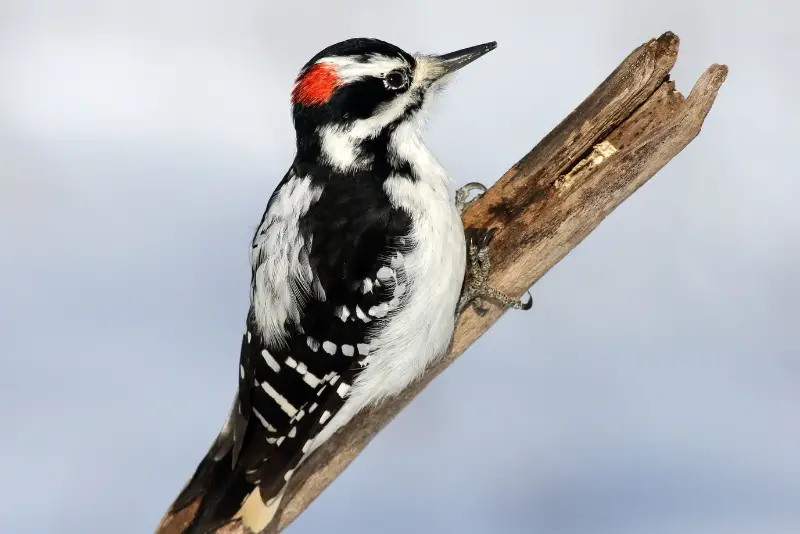
The Hairy Woodpecker looks similar to the Downy Woodpecker, but has a longer, thicker bill, and is a much larger bird overall.
Both the male and the female have black upperparts with white bars on the wing feathers, which look like spots when the wings are folded.
The male has a very small red patch on the back of its head, which is considerably smaller than the red patches on other woodpecker species.
The Hairy Woodpecker is a common breeding bird found throughout North America, and can be seen year-round.
This bird breeds in both coniferous and deciduous forests, and is even found in parks and other urban areas with trees.
Downy Woodpecker
Scientific name: Picoides pubescens

The Downy Woodpecker is the smallest woodpecker found in North America.
Males are small black-and-white birds with a prominent red patch on their nape, while females are entirely black and white.
The wings of both sexes are black with white bars, which look like spots when the wings are folded.
Downy Woodpeckers are non-migratory, and can be seen all year round in most parts of North America, but they don’t occur in the arid regions in the southwest.
You can tell this bird apart from the Hairy Woodpecker by its smaller size and short bill.
While these birds don’t migrate, they like to move around outside of the breeding season, in search of areas with plentiful food.
Their preferred habitat is deciduous or mixed forest, where they feed on insects and insect larvae found under the bark of trees. During winter they also eat berries and seeds.
Nuttall’s Woodpecker
Scientific name: Dryobates nuttallii
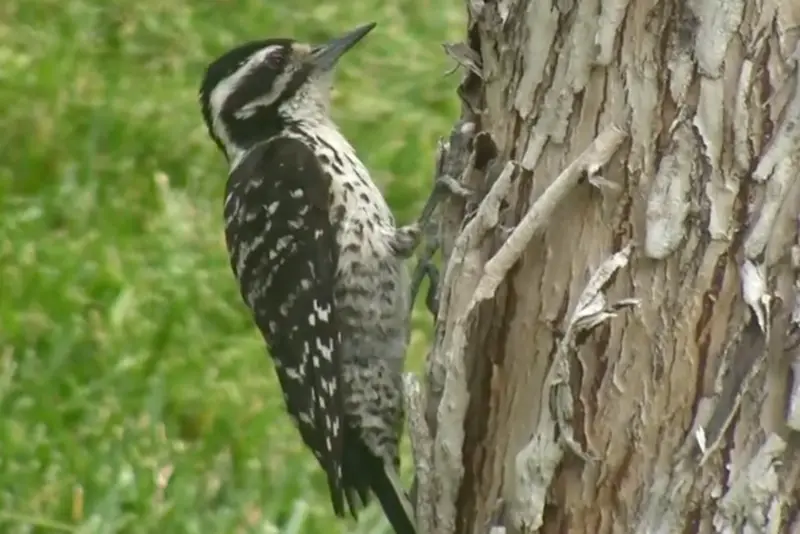
The Nuttall’s Woodpecker is a relatively small bird featuring exquisite horizontal black-and-white stripes on its head plus a black back highlighted by white spotting along with prominent white patches adorning its wings.
This lovely woodpecker is a resident of California where it graces areas from the north all the way down to Baja California located across the border in Mexico.
These birds are generally found living within oak woodlands, riparian woodlands or mixed forested regions – but they have been known to frequent chaparrals as well.
Their diet largely consists of acorns alongside an array of insects like beetles or ants; which form part of their usual habitat targets where they’ll utilize powerful bills both pecking at tree trunks plus probing branches as they seek out prey.
Ladder-backed Woodpecker
Scientific name: Dryobates scalaris
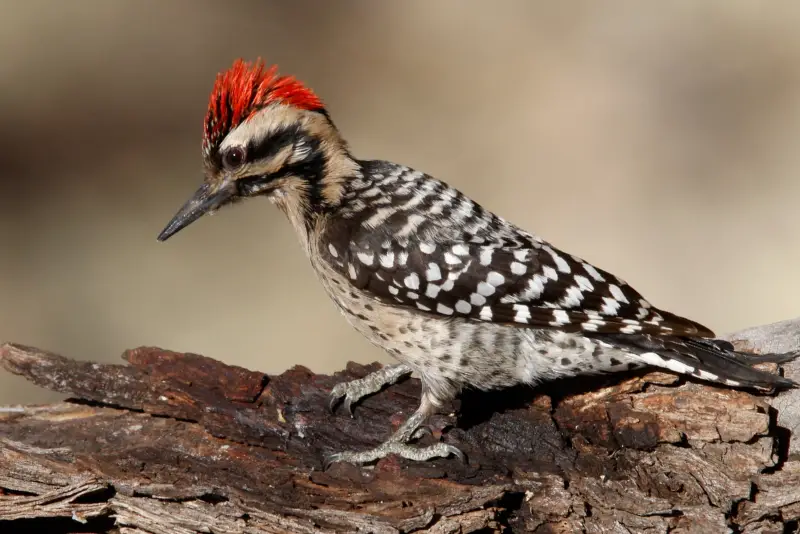
The Ladder-backed Woodpecker is a bird of the arid mesquite scrubland of the southwestern United States.
This small bird has a black and white checkered back as well as several horizontal black and white stripes on its face.
In addition, males have a bright red crown, while females lack the red feathers, and instead have a small orange patch on their forehead.
You can attract these attractive birds to your birdfeeder by offering mealworms or black oil sunflower seeds.
Red-cockaded Woodpecker
Scientific name: Dryobates borealis
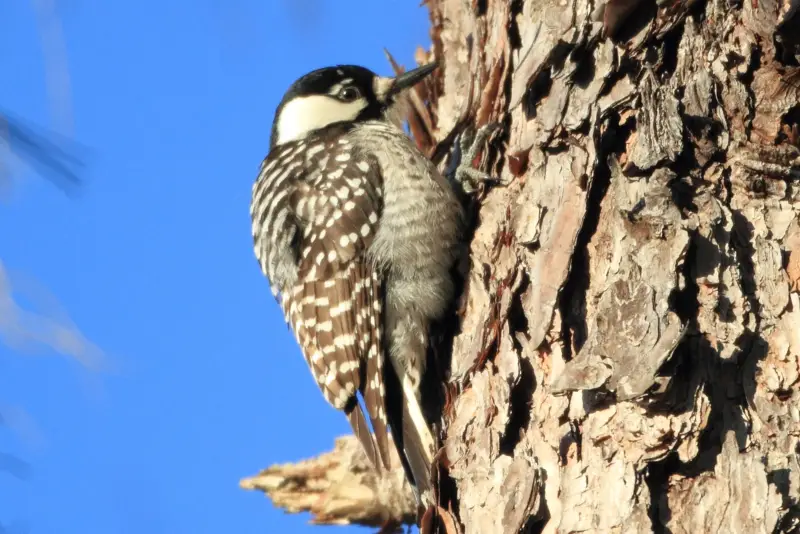
The Red-cockaded Woodpecker is a small dryobates species boasting beautiful black and white feathers characterized by distinct barred patterns on its back ,with clean-lined white cheeks as well as an attractive black cap.
Notably,the male birds feature a tiny red patch behind their eyes that distinctly sets them apart.
These birds are largely found in the southeastern United States of regions of longleaf pine ecosystems.
Mature pine forests consisting solely of old growth living trees are fundamental to this bird species for both nesting and feeding purposes.
This bird feeds mainly on insects such as ants, beetles, caterpillars, and spiders by pecking into tree bark using its sharp bill, thus controlling insect populations,and supporting overall ecosystem health and helping to preserve pine forests.
Acorn Woodpecker
Scientific name: Melanerpes formicivorus
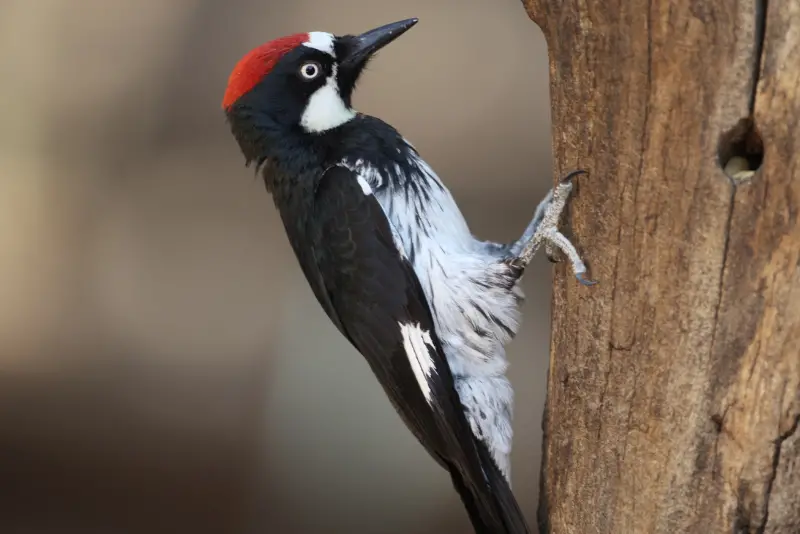
The Acorn Woodpecker is a colorful small bird that only occurs in a few areas of the southwestern and western United States.
While the back and wings of these birds are entirely black, their face has a large white patch on the throat and forehead, while the belly is white with black spots.
Both sexes also have a bright red patch on top of their head, and they are usually observed as part of a social group that forages together for acorns in open oak forests.
They store their acorns in trees that are riddles with small holes created by a group of Acorn Woodpeckers. These birds also nest communally, and cooperate in raising their young.
Red-breasted Sapsucker
Scientific name: Sphyrapicus ruber
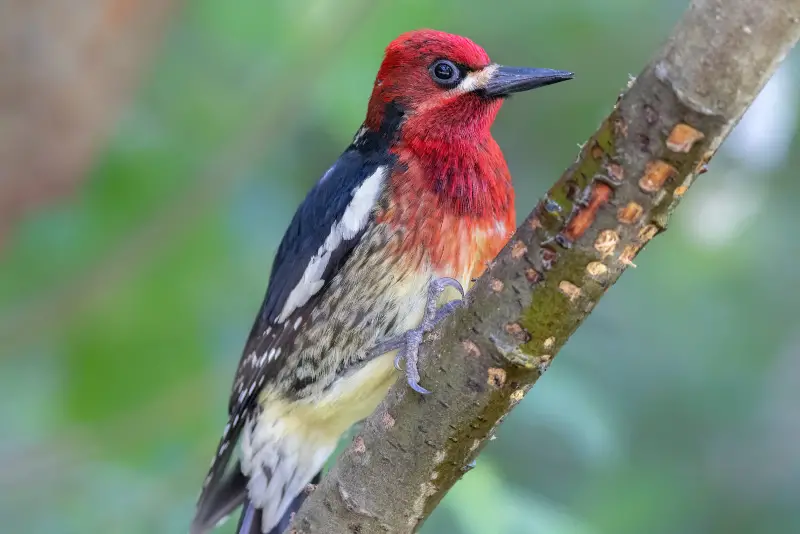
The Red-breasted Sapsucker is a striking member of the woodpecker family, due to the scarlet red head and breast of adult birds.
The back is greenish black with white spots, while the belly is cream colored with dark spots and streaks. Juvenile birds look similar, but lack most of the red coloration.
Red-breasted Sapsuckers are birds of westernmost North America, and occur in a band along the coast from southern California all the way up to southern Alaska.
They are regular breeding birds in mixed forests, and can also be encountered in other habitats during winter, when there is an influx of northern sapsuckers that migrate to the United States for the winter.
Red-naped Sapsucker
Scientific name: Sphyrapicus nuchalis
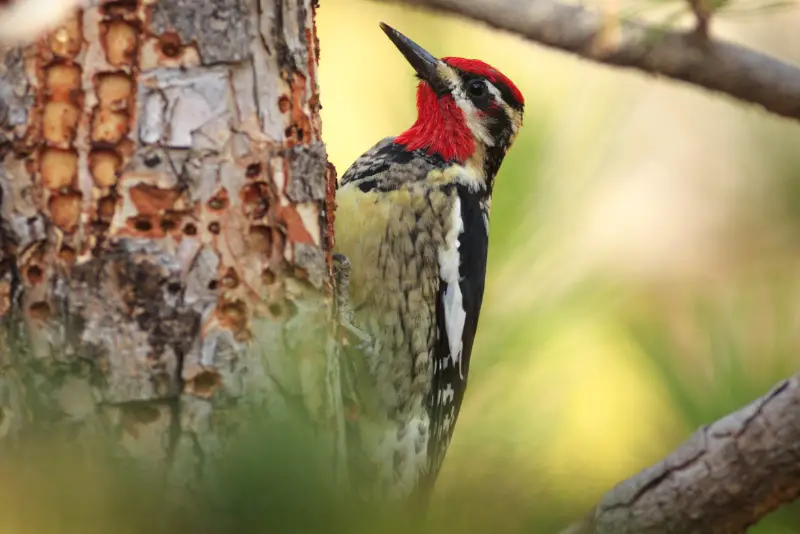
The Red-naped Sapsucker is a small sapsucker species with striking red coloration on the head. Adult birds have a bright red nape plus a red throat.
The partially red coloration on their head makes it easy to tell them apart from Red-breasted Sapsuckers, which have completely red colored heads.
The Red-naped Sapsucker is a breeding bird in the mountains of North America, and is more common during the winter months, when there is an influx of wintering birds from Canada.
Yellow-bellied Sapsucker
Scientific name: Sphyrapicus varius
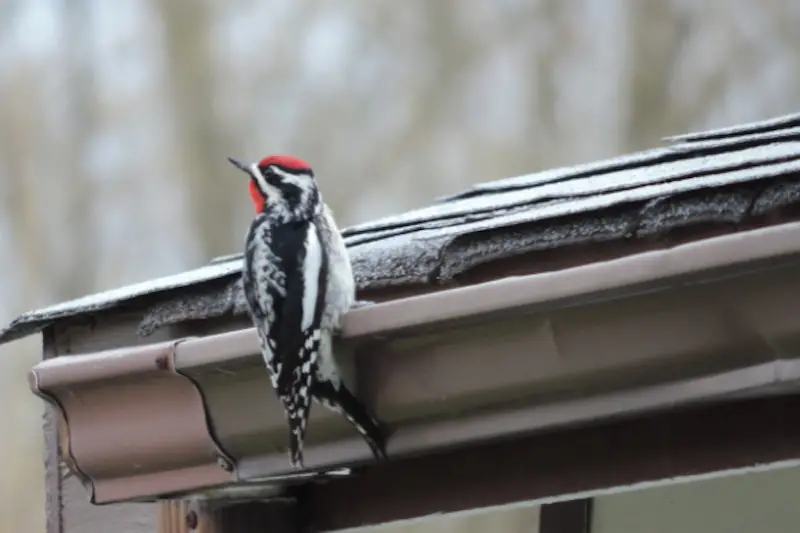
The Yellow-bellied Sapsucker is a breeding bird of Canada, and is a winter visitor in the southwestern United States.
The male has a checkered black and white back, as well as a scarlet red crown, forehead, and chin. It also has a yellowish tinge on its belly and chest. The female looks similar to the male, but has a white chin.
This sapsucker is found in small forests, as well as rural and suburban areas.
It drills holes into trees in order to drink the sap that oozes out, which it. The bleeding sap also attracts insects, which the Yellow-bellied Sapsucker feeds on.
Final remarks
In summary, here are the 15 types of black and white colored woodpeckers found in North America:
- White-headed Woodpecker
- Black-backed Woodpecker
- American Three-toed Woodpecker
- Red-headed Woodpecker
- Red-bellied Woodpecker
- Pileated Woodpecker
- Hairy Woodpecker
- Downy Woodpecker
- Nutall’s Woodpecker
- Ladder-backed Woodpecker
- Red-cockaded Woodpecker
- Acorn Woodpecker
- Red-breasted Sapsucker
- Red-naped Sapsucker
- Yellow-bellied Sapsucker
If you’ve spotted one of these birds while birdwatching in your backyard, hopefully this ID guide will help you identify it quickly and easily.
And if you enjoyed this article, check out our guide to the black and white species of hawks.
